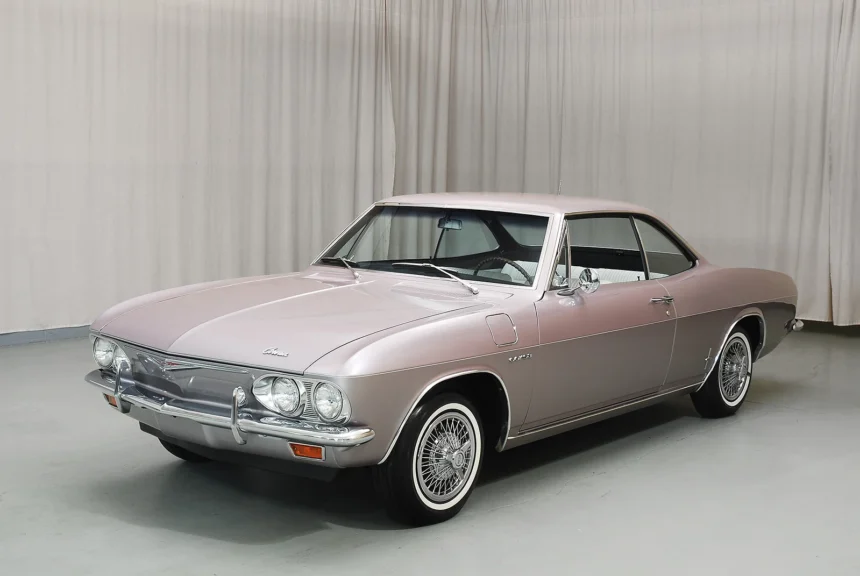The 1965 Chevrolet Corvair represents a pivotal moment in automotive history marking a unique intersection of innovation, controversy and style. Designed during a time when American manufacturers were experimenting with new vehicle layouts and ideas the Corvair dared to be different. With its air-cooled rear-mounted engine and sleek European-style design the 1965 Corvair earned both praise and criticism—leaving behind a legacy that still sparks debate among car enthusiasts.
Background: The Rise of the Corvair
In the late 1950s, Chevrolet aimed to compete with compact European imports like the Volkswagen Beetle. To achieve this, General Motors designed the Corvair as a lightweight compact and affordable car that broke away from American design traditions. It debuted in 1960 as the first mass-produced American vehicle with a rear-mounted air-cooled engine.
The 1965 model marked the second generation of the Corvair. With redesigned bodywork an improved suspension, and the availability of high-performance options the ’65 Corvair became the most refined and desirable iteration of the model line.
Exterior Styling: Sleek and Sporty Elegance
One of the most notable features of the 1965 Corvair is its clean, elegant design. Moving away from the boxier shape of earlier models, the second-generation Corvair featured a fastback roofline wider stance and flowing body lines. Its styling earned accolades from critics and enthusiasts alike with some calling it one of the most attractive cars ever produced by Chevrolet.
Key Exterior Features:
- Full-width grille with dual headlights
- Curved rear glass window for improved visibility and aesthetic appeal
- Flush-mounted taillights integrated into the rear design
- Sculpted fenders and sleek side panels
- Monza and Corsa trims offered sporty details like badging and brightwork
The 1965 Corvair was available as a coupe convertible and four-door sedan providing styling choices for a range of buyers.
Engine and Performance
What truly set the Corvair apart from its peers was its engineering. The 1965 Corvair featured a rear-mounted air-cooled flat-six engine—a layout more common in European cars like Porsche than American sedans.
Engine Specifications:
| Model | Engine Type | Horsepower | Induction |
| 500 | 164 cu in I6 | 95 HP | Single carburetor |
| Monza | 164 cu in I6 | 110 HP | Dual carburetors |
| Corsa | 164 cu in I6 | 140/180 HP | 4 carbs / Turbocharged |
The Corsa, introduced in 1965, was the performance model. It came with either a 140 HP engine with four carburetors or a 180 HP turbocharged version. The turbo variant gave the lightweight car impressive acceleration and speed for the time.
Transmission and Drivetrain
The Corvair offered multiple transmission options:
- 3-speed manual
- 4-speed manual (popular in performance trims)
- 2-speed Powerglide automatic
The car’s rear-engine layout gave it nearly 50/50 weight distribution, enhancing cornering and balance. Combined with independent suspension on all four wheels, especially the new fully independent rear suspension introduced in 1965, the Corvair handled with confidence and agility.
Interior Design and Features
The 1965 Corvair’s interior was simple yet thoughtfully designed. It featured a horizontal dash layout with chrome-accented gauges and padded surfaces for safety.
Interior Highlights:
- Bucket seats in Monza and Corsa models
- Optional AM/FM stereo and rear speaker
- Padded dashboard for improved safety
- Sporty instrument cluster with tachometer in Corsa trim
- Spacious rear seats for a compact car
Though modest by today’s standards, the Corvair’s interior was practical and stylish, aligning with the tastes of mid-1960s buyers.
Handling and Ride Quality
The 1965 model year addressed earlier handling concerns by replacing the swing-axle rear suspension with a Corvette-inspired independent rear suspension. This change significantly improved stability during cornering and reduced the risk of oversteer—a problem in earlier models.
Owners reported a confident ride, particularly in the Corsa model with upgraded suspension tuning. The car was praised for its “fun to drive” feel, something rare for American compacts of that era.
Controversy: “Unsafe at Any Speed”
In 1965, consumer advocate Ralph Nader published his landmark book “Unsafe at Any Speed.” The first chapter targeted the Corvair, accusing its early rear suspension design of causing instability and making it unsafe for drivers.
While the claims were based primarily on the first-generation models (1960–1964), the negative publicity affected all Corvair models, including the redesigned and much safer 1965 version.
Despite GM’s internal studies and later government investigations confirming the ’65 redesign addressed the safety concerns, the Corvair’s image never fully recovered. Sales dropped sharply, and the car was discontinued after 1969.
Legacy and Collector Appeal
Today, the 1965 Chevy Corvair has achieved a cult-like following among classic car enthusiasts. Its unique engineering, distinctive styling, and historical significance make it a favorite at car shows and in vintage collections.
Why Collectors Love the 1965 Corvair:
- Rare rear-engine American design
- Affordable and unique classic car
- Parts availability through enthusiast networks
- Easy to maintain compared to other classics
- Corsa Turbo models are especially desirable
Car clubs like the Corvair Society of America (CORSA) support ongoing interest and restoration of these vehicles.
Conclusion
The 1965 Chevrolet Corvair remains a fascinating and innovative piece of automotive history. With its bold engineering, European-inspired design, and performance potential it challenged American automotive norms. Despite the controversy that tainted its reputation, the ’65 Corvair stands today as a collectible gem, representing an era of experimentation and fearless design in the auto industry.
Whether you’re a vintage car collector a history buff or simply someone who appreciates unique vehicles the 1965 Corvair is a symbol of daring innovation worth celebrating.
Frequently Asked Questions (FAQs)
Q1. Is the 1965 Chevy Corvair safe to drive today?
Yes, the 1965 Corvair introduced a fully independent rear suspension that corrected the handling issues found in earlier models. With proper maintenance, it’s as safe as other cars of its era.
Q2. What’s the most desirable 1965 Corvair model?
The Corsa Turbo is the most sought-after due to its high-performance engine 4-speed manual transmission, and sporty interior features.
Q3. How much does a 1965 Corvair cost today?
Prices range from $8,000 for a base coupe in fair condition to over $30,000 for a fully restored Corsa Turbo convertible.
Q4. Is it hard to find parts for the Corvair?
Not at all. There are dedicated suppliers and active Corvair clubs that offer both OEM and aftermarket parts, making restoration manageable.
Q5. What makes the Corvair different from other classic Chevys?
Unlike most Chevys of the time, the Corvair has a rear-mounted air-cooled engine and independent suspension, giving it a unique place in American car history.




